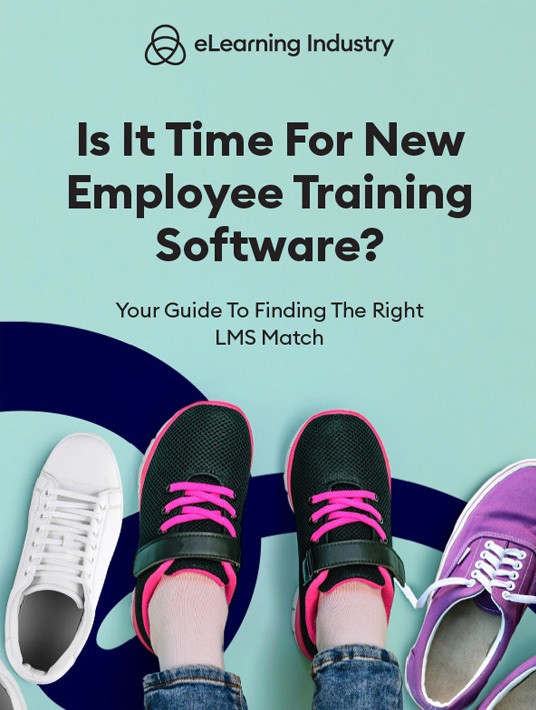5 Tips For Cost-Effective Employee Training Software
We get into our careers in different ways. We may have studied for it in school or followed the footsteps of someone we admire. And we certainly possessed the skill to get hired. Just as an example – say you’re an experienced truck driver. You may still need to learn how to drive your company’s trucks. At the very least, you’ll have to memorize their routes. Or get familiar with their customized GPS. Onboarding is all about taking your new hires’ general knowledge and shaping it to your company’s requirements. How can you achieve this affordably with a new employee training LMS? Here are some tips for training new employees so that they’re prepared for their first day on the job.

eBook Release
Is It Time For New Employee Training Software? Your Guide To Finding The Right LMS Match
This eBook will help you make a strong business case for new employee training software, as well as find the perfect LMS match for your organization.
1. Use The Free Training App
These days, mobile training is standard, and it can be especially helpful for new employees. You can include a link in their confirmation contract, inviting them to download the app. They can therefore begin their orientation sequence even before they report to the office. Because this mobile training component is such a big part of corporate education, many employee training LMS have apps. They generally take the form of mobile app templates. Populate it with your onboarding material and let your new staffers log in. The app already exists (even if it’s empty) so it won’t cost anything extra to get it fully running. You may have to pay for mobile data bundles though. This is a nice gesture, especially since they don’t (yet) have a salary.
2. Repurpose Current Resources
Regarding the question of where to find this content, you don’t necessarily have to hire subject experts. You probably have them within your corporate space, even if it hasn’t occurred to you. Talk to your HR or admin managers. Talk to department heads too. They’ll give you an overview of the skills required by new hires. Then look around the office and you’ll notice how much content exists. For example, just by reviewing customer invoices for the past few months, your newbies can learn your billing policies. Marketing collateral for trade shows and industry conferences offers vast amounts of product knowledge. Any TV/radio/podcast interview with the boss gives insight into the company’s history, mission, and vision. Start with those.
3. Encourage Employee-Generated Content
Along the same thought-stream, every existing employee was hired for a reason. And they must be doing well in their departments, otherwise, they wouldn’t still have a job. The nature of your organization may not allow shadow programs. (There isn’t enough scope or time.) But you can ask existing staff to pick a topic and produce training content. Ask them what questions they had when they first got the job. And ask them what they think new employees should know. Have them collate this information and upload it in a structure of their choice to the employee training software. Audios or videos on their phones, stylus sketches, comic strips, infographics, PowerPoint decks, PDF text – whatever works for them. This type of peer teaching is effective … and cost-friendly.
4. Host Live Events To Address Issues
Skill gaps don’t always appear in the form of missing job titles. Sometimes, you realize there’s a knowledge deficit on the fly. For example, if one new hire gets lost on the way to the bathroom, they might be clumsy or disoriented. By the time the 5th newbie ends up in the parking lot, you probably need some navigation guidelines. Or better wall signs. Or a closer toilet. This type of challenge doesn’t demand a course on the building layout. It could be solved by a quick ten-minute impromptu meeting. Preferably a standing one, so it doesn’t drag too long. Or even a walking tour where you physically guide the newbies around the building. Keep it playful and fun. Whenever they hear a signal – a phone reminder – they assemble at a meeting point. Then you’ll take them on a study break/toilet tour. Especially in the afternoon when everyone has the itis and is gazing unseeingly at their screens. Draft some talking points, call an emergency session, and resolve the skill gap instead of making a whole new three-month course.
5. Do A Quick Search Online
These days, even if you can’t afford university, you can take free courses online. You’ll be exposed to the same content as on-campus learners, though you won’t get accreditation or diplomas. Take this approach with your new hires. There are endless free training sources online. Curate these and put them into a palatable format using a rapid authoring tool and your employee training software. It costs you nothing (except time) and saves them the trouble of sifting through all that data themselves. Plus, this type of free content can be helpful for older hires too. Just make sure you give credit where credit is due to avoid copyright claims.
Conclusion
Onboarding is a very specific form of training. And these new hires cost money. You’ve just dented your bank balance by sourcing, interviewing, and paying these new employees. (Or at least, planning for their first paycheques.) You may not want to spend more training them. So how can you facilitate their organizational orientation on the cheap? Apply built-in employee training LMS apps. Repurpose existing data and content. Invite experienced staff to produce training materials. Teach quick lessons during meetings. Scour the net for free training resources. And remember, the target is retention. Save on their training so you can pay enough to keep them.
Choose a new employee training LMS that helps you stay within budget without sacrificing employee engagement. Our free online directory features the top platforms. You can search based on your key criteria, read reviews, or compare your top 3 options.
Download the eBook Is It Time For New Employee Training Software? Your Guide To Finding The Right LMS Match to make a strong business case for new employee training software and choose the best solution.

Homebase
Make work easier. Running a small business has never been harder. Homebase helps with free tools to track time and manage your team.




















